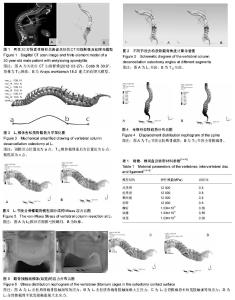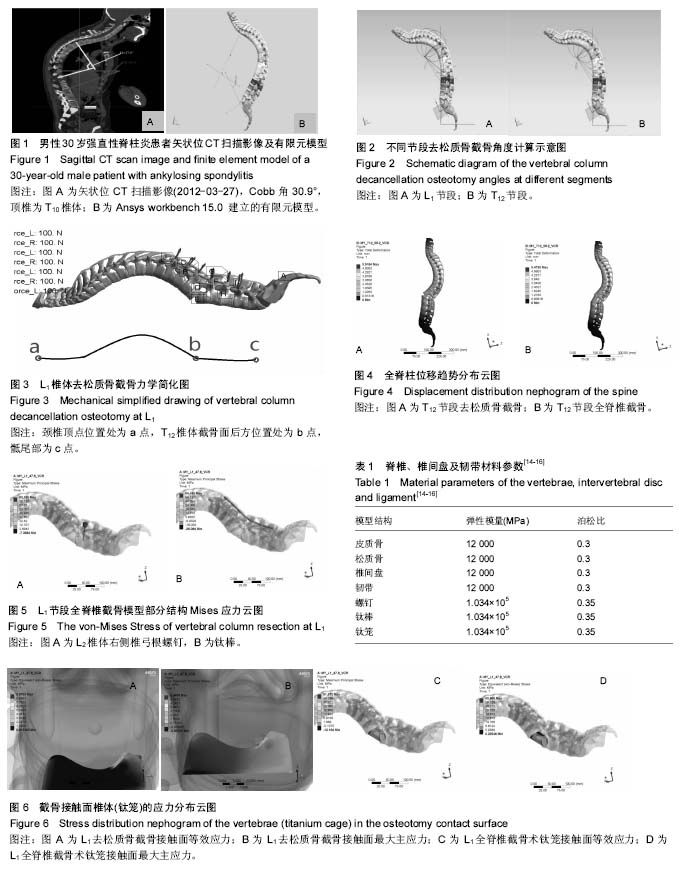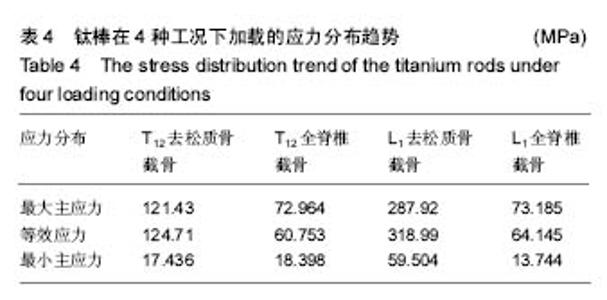| [1] Martindale J,Shukla R,Goodacre J.The impact of ankylosing spondylitis/axial spondyloarthritis on work productivity.Best Pract Res Clin Rheumatol. 2015;29(3):512-523. [2] Zhang X,Zhang Z,Wang J,et al.Vertebral column decancellation: a new spinal osteotomy technique for correcting rigid thoracolumbar kyphosis in patients with ankylosing spondylitis. Bone Joint J. 2016;98-B(5):672-678. [3] 马涌,斯刊达尔•斯依提,欧勇,等.不同截骨方式修复强直性脊柱炎后凸畸形的有限元分析[J].中国组织工程研究, 2017,21(19): 92-97.[4] Bess S,Harris JE,Turner AW,et al. The effect of posterior polyester tethers on the biomechanics of proximal junctional kyphosis: a finite element analysis. J Neurosurg Spine. 2017; 26(1):125-133. [5] 卢雨征.脊柱角状后凸畸形脊髓压迫的有限元分析及临床治疗分析[D].昆明医科大学,2016.[6] Cahill PJ,Wang W,Asghar J,et al. The use of a transition rod may prevent proximal junctional kyphosis in the thoracic spine after scoliosis surgery: a finite element analysis.Spine (Phila Pa 1976). 2012;37(12):E687-E695. [7] 赵志辉.人工椎体非融合技术的实现及其有限元分析[D]. 天津医科大学,2016.[8] Nigil Haroon N, Szabo E, Raboud JM,et al.Alterations of bone mineral density, bone microarchitecture and strength in patients with ankylosing spondylitis: a cross-sectional study using high-resolution peripheral quantitative computerized tomography and finite element analysis.Arthritis Res Ther. 2015;17:377. [9] 何剑颖,董谢平,舒勇,等.脊柱保护器对腰椎保护的有限元分析[J].中国矫形外科杂志,2015,23(6):74-81.[10] 孔超,鲁世保,张美超.有限元分析法在研究人工椎间盘置换生物力学中的应用[J]中国骨与关节杂志,2014,13(4):306-309.[11] 张宏伟,张晓刚,毛兰芳,等.有限元分析指导手法治疗单节段胸腰椎压缩骨折伴骨质疏松症29例[J].中医研究,2015,28(4):51-53.[12] Rudwaleit M,van der Heijde D,Landewe R,et al. The development of assessment of spondylo arthritis international society classification criteria for axial spondyloarthritis(part II):validation and final selection.Ann Rheum Dis. 2009;68:777-783.[13] 刘强,张军,孙树椿,等. 有限元在脊柱生物力学中的应用[J].中国骨伤,2015,30(2):99-103.[14] 武晓丹,张顺心,范顺成,等.三维有限元分析腰骶椎结构的动态特性[J].中国组织工程研究,2017,21(15):98-104.[15] 唐勇涛,魏思奇,吴长军,等.PKP不同增强方式对相邻椎体结构生物力学影响的有限元分析[J].中国骨科临床与基础研究杂志, 2017,9(3):41-48.[16] 杨敏,马向阳,杨进城,等.自行防旋转寰枢椎钉棒内固定系统的生物力学有限元分析[J].中国组织工程研究, 2017,21(19):85-91.[17] Lafon Y,Lafage V,Dubousset J,et al. Intraoperative three-dimensional correction during rod rotation technique. Spine (Phila Pa 1976). 2009 ;34(5):512-519. [18] 张冬冬,秦宝荣,王郑兴,等.秋千式办公休闲椅的设计及其力学性能研究[J].机械强度,2017,39(1):238-241.[19] 王宇,梅继文,穆尚强,等.新型弹性脊柱内固定器的设计与有限元分析[J].生物医学工程研究,2016,35(1):57-60.[20] 李辉,马俊毅,马原,等.构建强直性脊柱炎后凸畸形的三维有限元模型[J].中国组织工程研究,2017,21(7):91-95.[21] Park WM,Choi DK,Kim K,et al. Biomechanical effects of fusion levels on the risk of proximal junctional failure and kyphosis in lumbar spinal fusion surgery.Clin Biomech (Bristol, Avon). 2015;30(10):1162-1169. [22] Okamoto Y, Murakami H,Demura S,et al. The effect of kyphotic deformity because of vertebral fracture: a finite element analysis of a 10° and 20° wedge-shaped vertebral fracture model. Spine J. 2015;15(4):713-720. [23] Rajasekaran S,Natarajan RN,Babu JN,et al. Lumbar vertebral growth is governed by "chondral growth force response curve" rather than "Hueter-Volkmann law": a clinico-biomechanical study of growth modulation changes in childhood spinal tuberculosis. Spine (Phila Pa 1976). 2011;36(22):E1435-E1445. [24] Anasetti F,Galbusera F,Aziz HN,et al. Spine stability after implantation of an interspinous device: an in vitro and finite element biomechanical study. J Neurosurg Spine. 2010;13(5): 568-575. [25] 李天清,王军,冯亚非,等.人体颈椎松质骨显微结构和力学性能的区域性差异研究[J]. 中国骨质疏松杂志,2017, 23(5):19-24.[26] Driscoll C,Aubin CE,Labelle H,et al. The relationship between hip flexion/extension an the sagittal curves of the spine. Health Technol Inform. 2008;140:90-95.[27] 刘越,赵艳梅,夏群. 强直性脊柱炎的诊断与治疗进展[J].中国矫形外科杂志,2015,23(3):235-238.[28] 郑国权,张永刚,王岩,等.强直性脊柱炎后凸畸形的301分型[J].中国脊柱脊髓杂志,2015,25(9):769-774.[29] Behari S, Tungeria A, Jaiswal AK, et al. The "moustache" sign: localized intervertebral disc fibrosis and panligamentous ossification in ankylosing spondylitis with kyphosis. Neurol India. 2010;58(5): 764-767.[30] Wang JL,Parnianpour M,Shirazi- Adl A, et al.Viscoelastic finite-element analysis of a lumbar motion segment in combined compression and sagittal flexion. Effect of loading rate. Spine. 2000;25(3):310-318.[31] Burstein AH,Reilly DT,Martens M.Aging of bone tissue: mechanical properties. J Bone Joint Surg Am. 1976;58(1): 82-86. [32] Shirazi-Adl SA,Shrivastava SC,Ahmed AM.Stress analysis of the lumbar disc-body unit in compression. A three-dimensional nonlinear finite element study.Spine. 1984;9(2):120-134.[33] 金海明,王向阳.脊柱矢状面畸形截骨角度计算方法的研究进展[J].中华骨科杂志,2016,36(5):298-306.[34] Song K,Zheng G,Zhang Y,et al. A new method for calculating the exact angle required for spinal osteotomy.Spine(Phila Pa 1976). 2013;38(10):E616-E620. |





